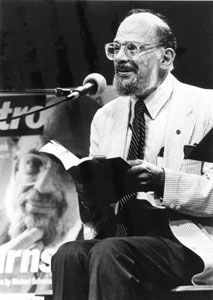![[Metroactive Books]](/books/gifs/books468.gif)
[ Books Index | Santa Cruz | Metroactive Home | Archives ]
Crying Howl: Allen Ginsberg is one of the key counterculture figures highlighted in Ken Goffman's new book.
Sirius Matters
In his new history of the counterculture, author Ken Goffman tracks down history's freethinkers
By Gary Singh
ON THE FIRST page of Counterculture Through the Ages: From Abraham to Acid House, author Ken Goffman, a.k.a. R.U. Sirius, affirms Nietzsche's eschewing history in favor of myth. The philosopher believed that myth creates a spiritual community that history squashes like a bug.
The pages that follow provide an expositive chronicle of freethinkers and myth seekers from Socrates to the current day, revealing how counterculture types tend to be folks who don't subscribe to any one specific dictum, ideology or reality tunnel. Instead, they put their hands in several pies, learn the recipes by osmosis and then morph them into their own pies, which eventually mutate, evolve and disappear. To these folks, myth and imagination are more interesting than raw glaring particulars. Thus, the book opens with a quote from Kesey: "To hell with facts! We need stories!"
As R.U. Sirius, Goffman has been around for a while. He helped run Mondo 2000, the original cyberpunk culture magazine in the late '80s and early '90s, back when merging computers with designer hallucinogenics and polysexuality was still punk. He also co-authored Timothy Leary's final book, Design for Dying. Unlike his 1992 volume, Mondo 2000 User's Guide to the New Edge, co-edited with local author Rudy Rucker and heiress Queen Mu, Goffman did not take an encyclopedic approach. Instead, he navigated a few of history's more important countercultural skeins, beginning with the yarns of Prometheus and Abraham, the latter of whom he calls the "original dropout." Other chapters deal with Bohemian Paris, jazz, the Beats, punk, trance music and the next wave of global digerati. Although seasoned counterculture aficionados will find a lot missing from the book, Goffman and co-author Dan Joy do provide an intellectual attempt at showing how all these radical mores are interconnected.
As a result, younger bohemian types just might want to flip open this manuscript and investigate their roots. Twelfth-century French troubadours migrate across the land and sing praises of the flesh and drink. Diogenes the Cynic of Ancient Athens ridicules the established order, and Taoist sages conceptualize anti-authoritarianism.
Now, conservatives will spout to their deaths that the '60s ruined America, but Goffman says anti-authoritarianism goes all the way back to Socrates. He quotes from Timothy Leary's autobiography, Flashbacks: "Like the Pied Piper, Socrates was a juvenilization agent, accused by conservative minds of the dangerous game of discomforting all authority before a circle of impressionable youths and subtracting from the state the stability of tradition ... his unsettling effect on the young and his persistent criticism were intolerable to any establishment."
In the chapter "A Different Type of Human Excellence," the authors loosely document the primary characteristics of countercultures in general: individuality at the expense of social conventions and governmental constraints; challenging authoritarianism in both obvious and subtle ways; and embracing constant change. Features of countercultures include the sharing of tools and resources; radical innovations in art, science and philosophy; diversity; persecution by mainstream culture; exile or dropping out.
The authors explain that "counterculturalists tend to be jokers, bohemians and libertines. These qualities subvert serious analysis, but we shouldn't diminish the importance of these stylistic undercurrents. ... Pranksters, cosmic jesters, yarn-spinning riddlers and defiant mockers of all that's pompous populate many of our stories. Countercultural playfulness represents the nonauthoritarian refusal to take oneself, any ideology, or any code of righteousness too seriously." The book's index alone reads like a heretical mishmash of the highest order and includes everything from the Yippies to Robin Hood.
Waiting For Goffman: Ken Goffman speaks at the Capitola Book Cafe Monday, Jan. 10.
But the book is not just a cheerleading exercise. Goffman trashes the '60s leftist culture: "Probably the major fallacy that guided the entire '60s epoch from idealism to lunacy was utopianism--Ginsberg's hallucination that he could 'seize power over the universe and become the next consciousness.' As a totalizing philosophy, utopianism is authoritarian in essence. (Jim Morrison sang about the hippie 'soft parade': Everything must be this way.)"
In a controversial chapter, the authors place the founding fathers in a completely different perspective: "For all the contradictions, the countercultural character of the American Revolution really comes from the freethinkers like Jefferson, Franklin, and Paine, who made it all happen. The makers of the Revolution were renaissance men who--besides being thinkers--were savvy businessmen, scientific dabblers and members of their colonial assemblies. Most were deists (though the Puritan influence lingered in the form of a strong work ethic), and many were high livers."
Now, defining "counterculture" is, above all, extremely problematic. One section in the book is even titled "Is Counterculture Counter Any More?" Goffman says that most of the flak he's received about the book has been from the left and not the right. "They said it's commodity culture, and they think [the book] didn't come out with a strong enough anti-corporate message," he said.
The classic complaint is that in a corporate-dominated society, anything "counterculture" or "underground" will eventually be co-opted by the capitalist machine. After Kurt Cobain died, "alternative" music became the most popular music on FM radio. Similarly, the 1970s punk records that conservative parents confiscated from their kids are now being used in car commercials. Everything gets commodified eventually, and Goffman says that this is the single most common issue that comes up when he talks about the book.
"That's finally the danger of the book that I'm flogging," he wrote in an online interview. "I've posted what I think are a great set of social values; but they are a linear list of values, and when we see those ideas bunched together in a book published by Random House, owned by Bertelsmann, it fairly screams 'LIFESTYLE FOR SALE.' My tendency when writing the book was to want to toss out all linear listings of countercultural attributes and to try to convey the essence of counterculture in a more expository style, to convey life as opposed to lifestyle. But life happens, even when you're trying to be stylish about it, so I'm sure people will continue to manifest counterculture in spontaneous, real ways and I will get pied and then go on to write more books for alternative and mainstream publishers."
[ Santa Cruz | Metroactive Central | Archives ]
Copyright © Metro Publishing Inc. Maintained by Boulevards New Media.
For more information about Santa Cruz, visit santacruz.com.
![]()

Photograph by Jim Mohs
The need for mystery is greater than the need for an answer.
Ken Kesey

Photograph by Christopher Gardner
Counterculture Through the Ages by Ken Goffman and Dan Joy; Villard; $25.95. Goffman appears Monday at 7:30pm at Capitola Book Café, 1475 41st Ave., Capitola. (831.462.4415)
From the January 5-12, 2005 issue of Metro Santa Cruz.